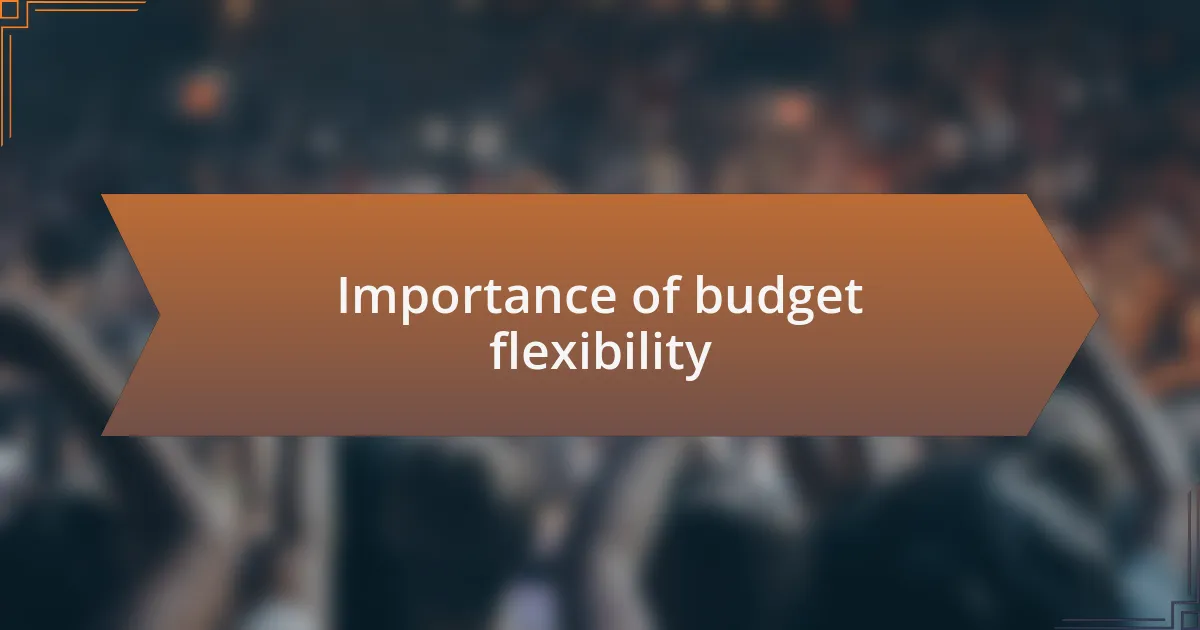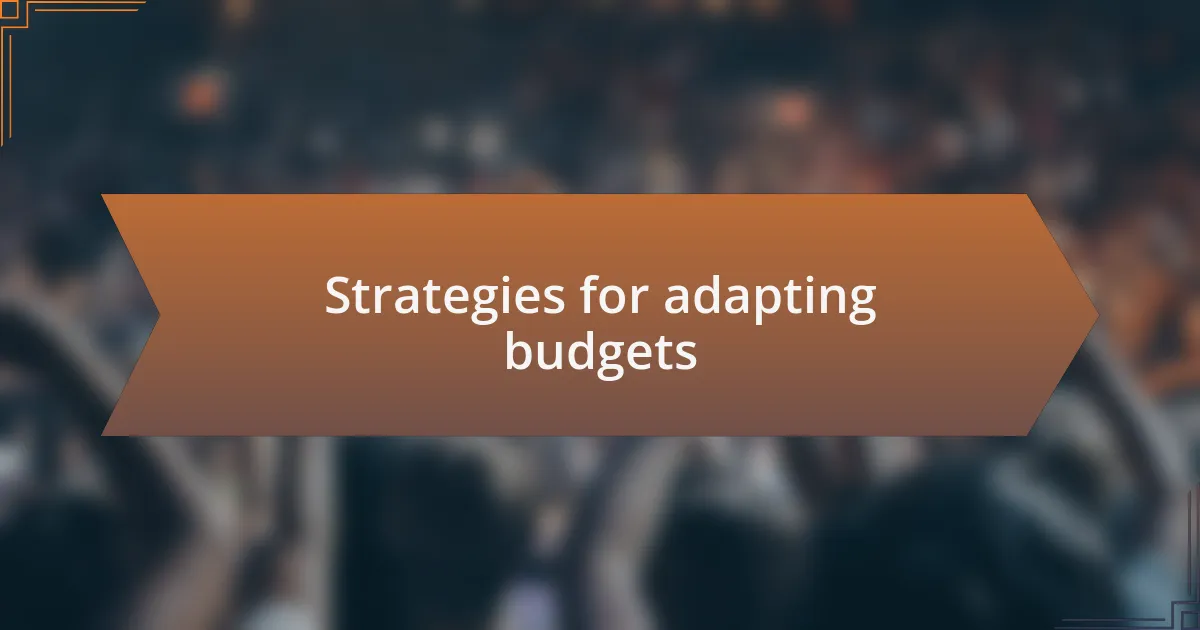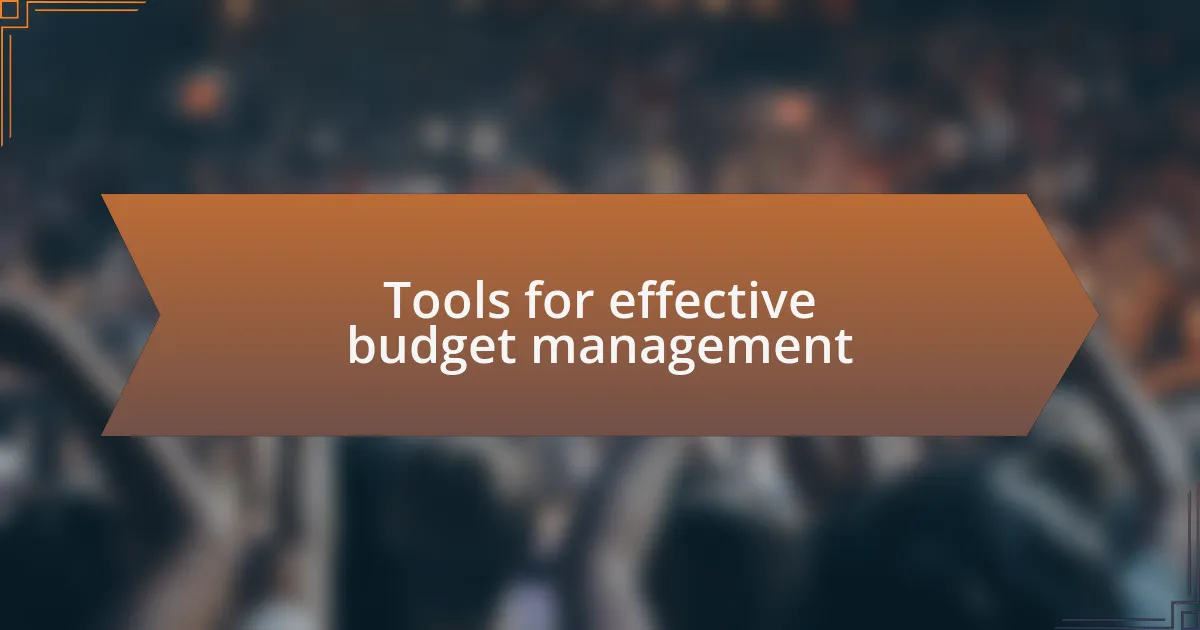Key takeaways:
- Event budgeting requires a blend of creativity and flexibility to accommodate unforeseen expenses and changes.
- Budget adaptability can lead to innovative solutions and new opportunities, enhancing overall event success.
- Effective communication and transparency with stakeholders are crucial during financial challenges to foster collaboration and trust.
- Incorporating a contingency fund and detailed tracking can significantly ease the management of unexpected costs in future events.

Understanding event budgeting
Event budgeting is not just about numbers; it’s about weaving together the vision of the event with the financial resources available. I remember planning a small community festival, where budgeting felt like fitting together pieces of a jigsaw puzzle. It took creativity to allocate funds for everything from vendors to entertainment, ensuring we could create an enjoyable experience without overspending.
Understanding the nuances of event budgeting means anticipating potential crises and preparing for them. There’s often a moment of panic when an unforeseen expense arises, like when my venue unexpectedly increased rental fees just a week before a big event. In that instance, I had to rethink allocations on the fly. It’s crucial to have a flexible mindset and strategies in place for quick adjustments.
Ultimately, every event is a unique blend of dreams and dollars, requiring ongoing evaluation. I often ask myself: How can I make the most impact with the resources I have? This question drives not just my budgeting decisions, but also my creativity, pushing me to find innovative solutions that enhance the overall experience while respecting financial constraints. Understanding that balance can truly elevate an event’s success.

Importance of budget flexibility
When I think about the importance of budget flexibility, I recall a time when a last-minute speaker cancellation forced me to completely reconfigure the agenda of a conference I was managing. I learned firsthand that being open to adjusting budget allocations allowed me to quickly redirect funds toward an engaging workshop instead, keeping attendees satisfied and the event running smoothly. This adaptability not only salvaged the day but also reinforced the idea that flexibility can elevate an event in unexpected ways.
I’ve found that a rigid budget often leads to missed opportunities. Consider a scenario where an exciting partnership opportunity arises, but your initial budget doesn’t have wiggle room. By allowing for some flexibility, I was able to incorporate an unexpected sponsorship that not only covered emerging costs but also enhanced our event’s visibility. This taught me that a flexible budget can create space for innovation that adds real value.
Moreover, encountering crises highlights the emotional aspect of budgeting in event management. The stress of looming deadlines and financial limitations can be overwhelming, but a flexible budget eases some of that pressure. I often pause to remind myself: how can a slight shift in budget allocations lead to an even more memorable experience for attendees? Embracing this question empowers me to pivot creatively, ensuring that challenges transform into exciting possibilities rather than setbacks.

Common crises affecting events
Crises can emerge unexpectedly, profoundly impacting event management. I recall a situation where an unforeseen natural disaster, like a sudden storm, disrupted venue arrangements. This experience taught me the importance of having contingency plans. It’s not just about adjusting budgets; it’s about quickly finding alternative locations and negotiating new contracts. How often do we really prepare for such drastic changes?
Another common crisis is the risk of vendor failures. I’ve experienced a vendor backing out at the last moment, which left me scrambling to find a replacement. This situation challenged my resourcefulness and tested my ability to adjust financial priorities on the fly. Have you ever been in a situation where your trusted supplier let you down? I certainly have, and it pushed me to diversify my vendor relationships, which ultimately strengthened my overall strategy.
Moreover, shifts in attendee expectations can also create a crisis after the budget is set. On one occasion, I noticed that social media trends influenced what organizers and guests anticipated for an event. Suddenly, interactive elements became a must-have. Managing those demands required immediate budget adjustments while maintaining quality. How can we keep our finger on the pulse of what participants truly want? It’s essential to stay informed and be ready to adapt because understanding attendee desires can transform what might have been a crisis into an opportunity for deeper engagement.

Strategies for adapting budgets
When faced with crises, I often prioritize essential expenses by revisiting my event’s overall goals. For instance, during a budget crunch after a sudden drop in sponsorships, I focused on the core aspects that directly impacted attendee experience rather than peripheral elements. Have you ever found yourself having to make such tough choices? It can be a gut-wrenching process, but this approach often clarifies where to allocate resources effectively.
Another strategy I’ve found valuable is leveraging technology for cost-effective solutions. In one particular instance, a venue cancellation forced me to transition to a virtual format. While it was daunting at first, embracing digital platforms allowed us to significantly lower our overhead while reaching a wider audience. It made me realize that sometimes, a crisis can push us into innovative territory we never considered before. Have you explored technology’s role in creating memorable experiences even on a tight budget?
Additionally, I’ve learned the importance of continuous communication with all stakeholders regarding budget adaptations. Clearly conveying financial constraints to vendors and partners during a crisis has led to renegotiated terms or creative compromises. I remember a time when a vendor offered a discount on services because they understood our challenges. Building those relationships feels rewarding, doesn’t it? Transparency cultivates trust, and that trust can become a lifeline during turbulent times.

Personal experience during crises
Navigating through crises has often felt like walking a tightrope for me. I recall a particularly challenging moment when the unexpected happened: a leading sponsor pulled out just weeks before the event. It forced me to pivot quickly, trimming unnecessary expenses while focusing on what would keep attendees engaged. The pressure felt immense, but it also ignited creativity I didn’t know I had. Have you ever experienced such a pivotal moment that transformed your approach?
During another crisis, I found solace in collaboration. A sudden spike in costs made it clear that I couldn’t shoulder everything alone. I reached out to different event professionals, asking for their insights on how they were balancing budgets. One colleague suggested a joint marketing effort that, surprisingly, brought us both higher visibility without stretching our finances. That sense of community reminded me that, in times of uncertainty, we often uncover new paths together. Have you ever leaned on your network to discover innovative solutions?
There was a time when I had to face the emotional weight of budget cuts head-on. I vividly remember gathering my team to discuss these changes, feeling the tension brewing in the room. As we explored options together, I realized that openness about our struggles encouraged my team to share their ideas and feelings too. It wasn’t just about adjusting numbers; it was about fostering a sense of unity in navigating rough waters. Isn’t it incredible how vulnerability can lead to stronger teamwork?

Tools for effective budget management
Tools for effective budget management can transform the way we navigate financial challenges in event management. One platform that I swear by is budgeting software tailored for events. These tools allow you to track expenses in real-time, helping to ensure that you’re staying within your limits. Have you ever experienced the relief of seeing everything in one place, allowing you to make decisions on the fly? It feels empowering.
Another key resource is spreadsheets. While it may sound basic, I’ve found them to be incredibly versatile. Creating my own budget template, I can customize it with specific categories that reflect my events’ unique needs. This flexibility provides a sense of control that is essential during a crisis. Have you ever felt the satisfaction of crafting something that suits your exact situation? It can be a game changer.
Lastly, I can’t stress enough the importance of technology for communication in budgeting. Tools like project management apps allow for seamless collaboration with my team. Sharing updates and adjustments in real-time reduces confusion and fosters transparency. Do you remember the last time everyone was on the same page? It not only saves time but builds trust, and that’s invaluable when navigating financial tight spots.

Lessons learned for future events
When reflecting on the lessons learned for future events, adaptability stands out as a crucial takeaway. I vividly recall a time when unexpected costs hit my event budget hard. It taught me to always have a buffer in place. Now, I recommend incorporating a contingency fund into your planning. Have you thought about how a little extra cushion can help ease worries down the road?
Another important lesson is the value of detailed tracking. During crises, I struggled with tracking expenses and lost sight of my budget. Now, I break down my spending into precise categories, making it easier to identify where I can cut back. This practice not only aids in controlling costs but also enhances my decision-making process. Have you noticed how clarity can lighten the load?
Lastly, open lines of communication are essential. I remember when my team and I failed to share updates effectively, leading to misunderstandings that spiraled out of control. This experience taught me that regular check-ins and shared access to budget documents are vital. How often do you connect with your team about financial updates? Strengthening this aspect can foster a collaborative spirit, making it easier to pivot plans as needed.